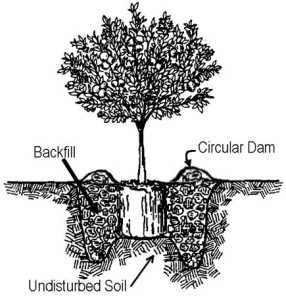
 Citrus are among the most versatile of the trees and shrubs that grow in our Valley. They can be trained as a single specimen, in hedges, as a trellised espalier or in containers. Citrus plants offer beautiful evergreen foliage, fragrant flowers and delicious decorative fruit. Fall, with its milder temperatures, is a perfect time to plant citrus. Establishing a citrus plant before frost can help it weather the winter.
Citrus are among the most versatile of the trees and shrubs that grow in our Valley. They can be trained as a single specimen, in hedges, as a trellised espalier or in containers. Citrus plants offer beautiful evergreen foliage, fragrant flowers and delicious decorative fruit. Fall, with its milder temperatures, is a perfect time to plant citrus. Establishing a citrus plant before frost can help it weather the winter.
Citrus prefer a hot south or west facing location with good draining soil. A reflective wall or fence is helpful and planting citrus under the south or west facing eve of the house will provide valuable protection from cold winter temperatures. Citrus should not be planted in a low or soggy spot that has poor drainage or in a lawn. In fact, if possible, place the citrus in a raised bed for improved drainage.
Dig a planting hole three times as wide as the root ball and just as deep as the root ball. The edges of the planting hole should then be dug out deeper than the center to accommodate additional soil amendments.
Test how well the planting hole drains by filling the 1′ deep x 3′ wide hole 1/2 way with water. Make sure it drains completely overnight. If the water does not drain, it may be necessary to raise the overall soil level by creating a mound or building a planting box or look for an alternate planting location. An open-bottom-box measuring 3’x3′ wide and 12″ deep makes a great raised bed.
Plant by carefully removing the tree from its container. Gently loosen the outer edges of the root ball if the roots are tight and place it in the hole so that the top of the root ball rests slightly higher than the existing ground level (never add any soil above the root ball, covering the stem). Improve the existing soil from the planting hole with Master Nursery Acid Planting Mix at a ratio of 75% Planting mix to 25% existing soil. To this improved soil, add the appropriate amount of Master Nursery Master Start or Sure Start and Iron Sulfate or Iron Plus; mix thoroughly. Backfill around the root ball with the improved soil mixture. Tamp to compress the soil as you go. Use some of the extra soil to build a circular dam around the new plant to hold a generous quantity of irrigation water.
 Water the plant thoroughly in the pot before planting and then again after you have finished planting it. Let the water soak in, and then water a third time. Citrus plants need less frequent watering than most garden plants once established. Give it a deep soak once or, at most twice week once established. Frequent watering is the most common cause of failure with citrus. Of course, if the weather is excessively hot, check daily and water as needed.
Water the plant thoroughly in the pot before planting and then again after you have finished planting it. Let the water soak in, and then water a third time. Citrus plants need less frequent watering than most garden plants once established. Give it a deep soak once or, at most twice week once established. Frequent watering is the most common cause of failure with citrus. Of course, if the weather is excessively hot, check daily and water as needed.
Begin to feed your new plant after a month with Master Nursery Citrus Food. Citrus plants appreciate a steady, light feeding, so divide a year’s supply of fertilizer into 12 equal parts and give your new plant a monthly feeding, year-round.
